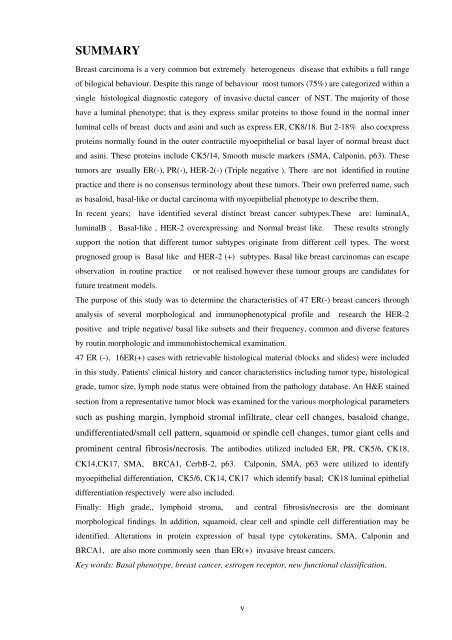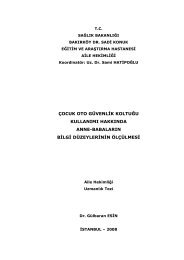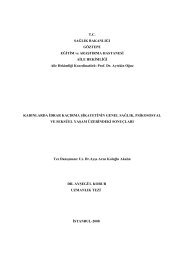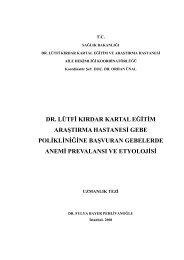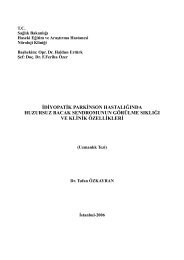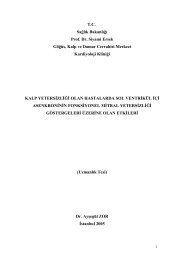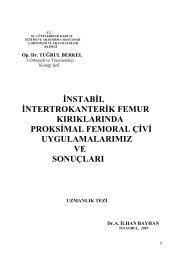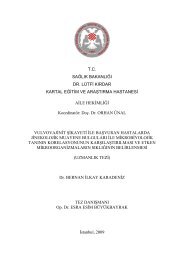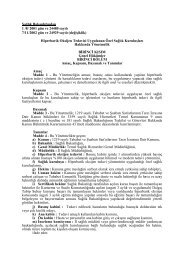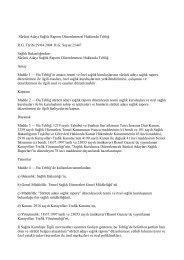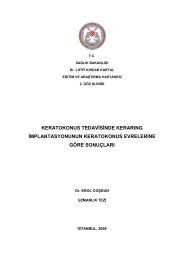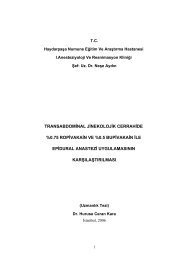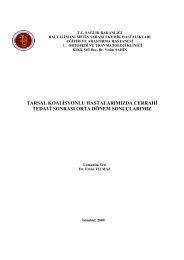ÖSTROJEN RESEPTÖRÜ NEGATİF İNVAZİV MEME ...
ÖSTROJEN RESEPTÖRÜ NEGATİF İNVAZİV MEME ...
ÖSTROJEN RESEPTÖRÜ NEGATİF İNVAZİV MEME ...
Create successful ePaper yourself
Turn your PDF publications into a flip-book with our unique Google optimized e-Paper software.
SUMMARY<br />
Breast carcinoma is a very common but extremely heterogeneus disease that exhibits a full range<br />
of bilogical behaviour. Despite this range of behaviour most tumors (75%) are categorized within a<br />
single histological diagnostic category of invasive ductal cancer of NST. The majority of those<br />
have a luminal phenotype; that is they express smilar proteins to those found in the normal inner<br />
luminal cells of breast ducts and asini and such as express ER, CK8/18. But 2-18% also coexpress<br />
proteins normally found in the outer contractile myoepithelial or basal layer of normal breast duct<br />
and asini. These proteins include CK5/14, Smooth muscle markers (SMA, Calponin, p63). These<br />
tumors are usually ER(-), PR(-), HER-2(-) (Triple negative ). There are not identified in routine<br />
practice and there is no consensus terminology about these tumors. Their own preferred name, such<br />
as basaloid, basal-like or ductal carcinoma with myoepithelial phenotype to describe them.<br />
In recent years; have identified several distinct breast cancer subtypes.These are: luminalA,<br />
luminalB , Basal-like , HER-2 overexpressing and Normal breast like. These results strongly<br />
support the notion that different tumor subtypes originate from different cell types. The worst<br />
prognosed group is Basal like and HER-2 (+) subtypes. Basal like breast carcinomas can escape<br />
observation in routine practice or not realised however these tumour groups are candidates for<br />
future treatment models.<br />
The purpose of this study was to determine the characteristics of 47 ER(-) breast cancers through<br />
analysis of several morphological and immunophenotypical profile and research the HER-2<br />
positive and triple negative/ basal like subsets and their frequency, common and diverse features<br />
by routin morphologic and immunohistochemical examination.<br />
47 ER (-), 16ER(+) cases with retrievable histological material (blocks and slides) were included<br />
in this study. Patients' clinical history and cancer characteristics including tumor type, histological<br />
grade, tumor size, lymph node status were obtained from the pathology database. An H&E stained<br />
section from a representative tumor block was examined for the various morphological parameters<br />
such as pushing margin, lymphoid stromal infiltrate, clear cell changes, basaloid change,<br />
undifferentiated/small cell pattern, squamoid or spindle cell changes, tumor giant cells and<br />
prominent central fibrosis/necrosis. The antibodies utilized included ER, PR, CK5/6, CK18,<br />
CK14,CK17, SMA, BRCA1, CerbB-2, p63. Calponin, SMA, p63 were utilized to identify<br />
myoepithelial differentiation, CK5/6, CK14, CK17 which identify basal; CK18 luminal epithelial<br />
differentiation respectively were also included.<br />
Finally: High grade,, lymphoid stroma, and central fibrosis/necrosis are the dominant<br />
morphological findings. In addition, squamoid, clear cell and spindle cell differentiation may be<br />
identified. Alterations in protein expression of basal type cytokeratins, SMA, Calponin and<br />
BRCA1, are also more commonly seen than ER(+) invasive breast cancers.<br />
Key words: Basal phenotype, breast cancer, estrogen receptor, new functional classification.<br />
v


